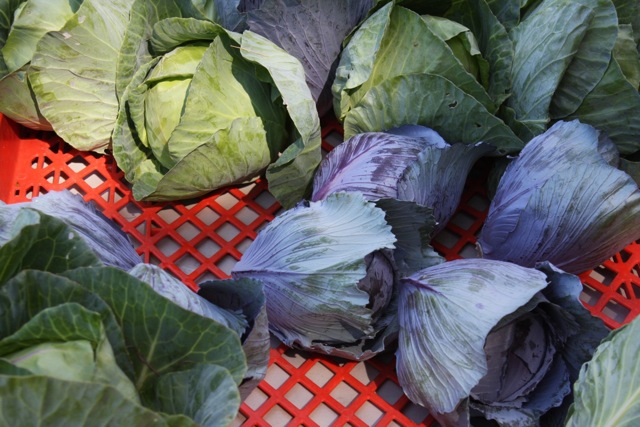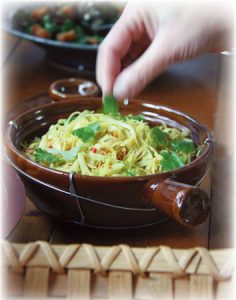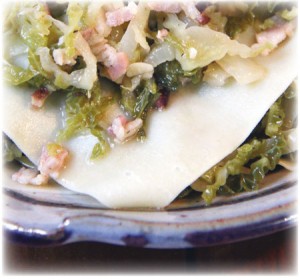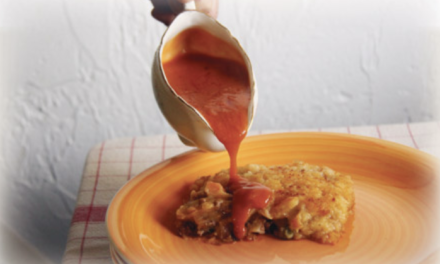by Joan Kocsis.
When I first lived on my own, I compared prices for iceberg lettuce and a similar-looking head of cabbage and opted for the cabbage, thinking it was almost the same thing but cheaper. When I cut it into the same big chunks as iceberg and tried to eat it as a salad, however, my mistake became obvious.
Although my food prep skills were primitive, my instincts were good. Cabbage is not just a bargain; it’s also crispy, sweet, high in vitamin C and fiber, and rich in cancer-preventing compounds (like its relatives kale, broccoli, and cauliflower). And talk about versatile! Shred it finely and it’s a coleslaw, or make sauerkraut by salting and weighting it. Slice it less finely and it stir-fries beautifully. And in quarter-inch or larger slices, cabbage becomes a succulent braised vegetable. For many backyard gardeners, however, cabbage is not easy to grow, so I’m thrilled when I find enormous, perfect heads of organically grown cabbage at farmers’ markets.

Cabbage
Many local people grew up eating cabbage in one form or another, depending on their heritage. For some, it just wouldn’t be St. Patrick’s Day without corned beef and cabbage (although this seems to be an Irish-American tradition). Early English settlers brought a similar dish we know as New England boiled dinner (preserved beef, cabbage, and root vegetables), which has nourished generations of their descendants.
A friend of Lithuanian stock smiled blissfully as she recalled sneaking handfuls of her mother’s sauerkraut from the wooden barrel in the cellar. Pickling cabbage started in China and is embedded in the cuisine of many countries, including Korea (think kimchi). In France choucroute is a specialty of Alsace. Eaten raw, sauerkraut is tangy and chewy, good on hot dogs, reubens, and other sandwiches. When cooked, sauerkraut acquires complexity and sweetness. Making small batches of it is easy (any number of websites offer instructions), but filling barrels with it is a big undertaking. In countries such as Hungary, come fall, roving sauerkraut makers would apply their strong arms and razor-sharp blades to heaps of cabbages to produce a family’s winter supply.
Cabbage is probably most often consumed hereabouts in the form of coleslaw, a term anglicized from the Dutch koolsla. The idea may not excite you, but coleslaw doesn’t have to be a limp afterthought, a grudging nod to the vegetable kingdom, falling off a fried seafood platter. Done right, it is food of the gods. Some slaw makers are in the oniony camp, while others wouldn’t dream of sullying their slaw with the fragrant bulb. Some like it noticeably sweet; some don’t. Accents of grated carrot, sweet peppers, red cabbage, apples, and even currants boost flavor and visual appeal.

Cabbage at Farmers’ Market
I prefer coleslaw oniony and will use any type of onion, including chives and scallions, but the sugar in commercial mayonnaise makes it sweet enough for my taste. Dill or celery seed often flavors my slaws, but freshly ground caraway, coriander, or cumin seeds are also good. Dribble in a judicious amount of vinegar, and your slaw is made. Slaws dressed with olive oil, or even toasted sesame oil, are just as good as the mayo kind. One favorite recipe uses Thai fish sauce, rice vinegar, a little sugar, red pepper flakes, scallions, snow peas, and no fat at all.
So, I have made many forms of coleslaw, some well-loved batches of sauerkraut, and boiled dinner. But I had never cooked the vegetable by itself. Bad smells topped my list of reasons for avoiding it (how many writers have set the scene for stories of struggling immigrants with stairwells reeking of overcooked cabbage?). Blandness was another reason.
That was before I discovered braised cabbage. Slow cooking in a small amount of liquid after an initial sauté is now my ideal way to prepare cabbage. Two fabulous recipes changed my preconceptions, and now I want to shout it from the rooftops: Braised cabbage is good enough for company! It’s also a luscious side dish for an everyday family meal—and the aromas are great, possibly because it starts with sautéing and doesn’t cook long. The basic technique accommodates other additions, including onion, garlic, ginger, chilies, peppers, carrots, peas, cream, nutmeg, or fresh herbs. A recent dish modeled on the Indian recipe below employed a large onion in slices, half a cabbage in coarse shreds, some chopped plum tomatoes, and a little water. After a 20-minute braise, I stirred in fresh basil and grated Fontina cheese for a delicious light lunch.
So if you’ve been giving cabbage a raw deal, disdain the humble cabbage no more! One of these recipes could open you up to a new world of tastiness.
Joan Kocsis: Cooking unpopular vegetables is a good way to unwind after a day of arranging words. Last year she finally harvested her first decent-size homegrown cabbage.
 Spiced Smothered Cabbage Recipe
Spiced Smothered Cabbage Recipe
Adapted from Julie Sahni’s Classic Indian Cooking
 Buttery Cabbage Lasagna Recipe
Buttery Cabbage Lasagna Recipe
Adapted from Blue Ginger: East Meets West Cooking with Ming Tsai




